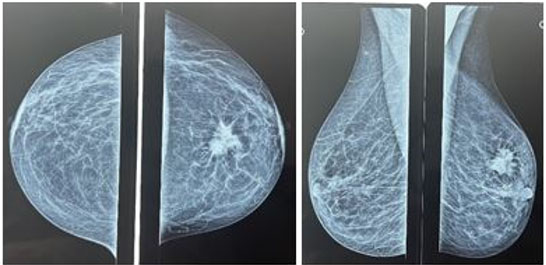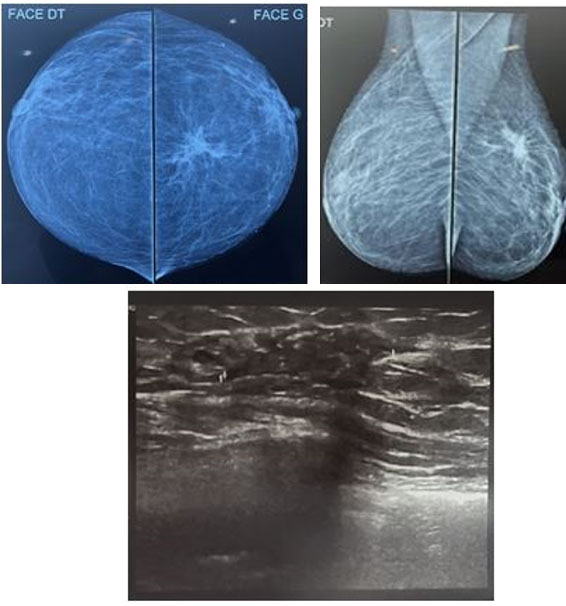 |
Case Report
Squamous cell carcinoma of the breast: A case report and review of the literature
1 Centre Hospitalier Universitaire Ibn Rochd, Faculté de Médecine et Pharmacie, Université Hassan II de Casablanca, Casablanca, Morocco
Address correspondence to:
Hlaibi Omnia
Centre Hospitalier Universitaire Ibn Rochd, Faculté de Médecine et Pharmacie, Université Hassan II de Casablanca, Casablanca,
Morocco
Message to Corresponding Author
Article ID: 100030G06FI2023
Access full text article on other devices

Access PDF of article on other devices

How to cite this article
Issam F, Omnia H, Maha M, Ennachit S, Mustapha B, Elkarroumi M. Squamous cell carcinoma of the breast: A case report and review of the literature. Edorium J Gynecol Obstet 2023;8(1):4–7.ABSTRACT
Breast squamous cell carcinoma (SCC) is a rare form of breast cancer and is highly malignant; diagnosis is based on histological examination after eliminating the primary tumor; clinical and radiological examination is not specific; treatment is the same as for invasive ductal carcinoma; prognosis is poor due to tumor size and lymph node involvement. We report a case of breast SCC in a 53-year-old patient who was examined in the obstetrics and gynecology department of the hospital in Casablanca. Through this case, we raise the main characteristics of this rare type of breast cancer. As a conclusion, the etiology and pathogenesis of SCC of the breast is still unclear.
Keywords: Breast, Diagnosis, Prognosis, Squamous cell carcinoma, Treatment
INTRODUCTION
Breast squamous cell carcinoma (SCC) is a rare form of breast cancer and is highly malignant. It is defined by the World Health Organization (WHO) as “a breast carcinoma entirely composed of metaplastic squamous cells that may be keratinizing, nonkeratinizing, or spindled; neither derived from the overlying skin nor representing metastases from other sites” [1].
It is characterized by a rapid evolution and an uncodified treatment [2]. Due to the rarity of this neoplasm, data on its diagnosis, treatment, and prognosis are limited [3].
We report a new case of SCC of the breast, we will emphasize through a review of the literature the characteristics of this particular form of breast cancer.
CASE REPORT
Mrs Q.H., a 53-year-old, mother of 1 child living by vaginal delivery, menopausal for two years, consulted for further management of a left breast neoplasm.
The history of the disease goes back to one year and a half with the autopalpation of a nodule of the left breast, the initial clinical examination finds a mass of 5 cm at the junction of the left upper quadrants mobile, the initial echo-mammography objectified a suspicious lesion at the union of the left upper quadrants, measuring 30×21 mm, classified as Breast Imaging-Reporting and Data System 5 by the American College of Radiology (Figure 1), the biopsy with the trucut showed a well-differentiated keratinizing epidermal mammary carcinoma with the presence of carcinomatous lymphangitis, hormone receptor negative, Human Epidermal Growth Factor Receptor positive, Ki 67 = 30%.
The extension workup did not find any suspicious secondary lesions. The patient received 6 courses of neoadjuvant chemotherapy, based on taxanes and trastuzumab (end of 26/10/22) then once the chemotherapy sessions were over, the patient was referred for surgery.
The current clinical examination did not reveal any palpable mass or inflammatory sign or nipple discharge in both breasts. Post-chemotherapy ultrasound mammography showed regression of the lesion straddling the upper left quadrants measuring 23×15 mm classified as Breast Imaging-Reporting And Data System 6 by the American College of Radiology (Figure 2).
She was scheduled for a left mastectomy with sentinel lymph node. Unfortunately, the patient died following a pulmonary tuberculosis added to the immunodepression chemo induced.
DISCUSSION
Squamous cell carcinoma of the breast is an infiltrating ductal carcinoma with squamous cell-like metaplastic changes, in the absence of any other ductal or mesenchymal neoplastic component and other distant SCC sites [2].
The concept of a continuum of disease with varying degrees of squamous metaplasia has been supported by Stevenson et al. who conclude that SCC primarily represents an extreme form of squamous metaplasia within adenocarcinoma. Another theory is that these tumors arise directly from the epithelium of the mammary ducts [4].
Pure primary squamous cell carcinoma of the breast has been diagnosed in adult women aged 29–90 years. No cases have been described in men. It tends to be relatively large (>4 cm) at diagnosis and cystic in 50% of cases. Some authors have noted only rare lymph node involvement [5].
There are no specific features of primary SCC on mammography or ultrasonography [2], but sometimes ultrasonography can show a complicated cyst or an inflammatory process [5].
Immunohistochemistry shows expression of high molecular weight cytokeratins in epithelial tumor cells, including CK14, CK5/6, and CK17. However, the majority of these tumors do not express hormone receptors, which is consistent with our patient, and Human Epidermal Growth Factor Receptor 2 amplification is often absent. On the other hand, the proliferative character (Ki 67) has been strongly demonstrated by the study conducted by Grenier et al. [6],[7].
Treatment does not differ from other histological types of breast cancer and may involve surgery, chemotherapy, hormonal therapy, and radiotherapy. Due to its rarity, the most appropriate therapeutic regimen is not yet clear [4],[8].
As for metastasis, SCCs are thought to have less lymphatic spread than adenocarcinomas. In 10–30% of cases, there is lymph node infiltration at the time of surgery. In contrast, about 30% of patients will develop distant metastases [1].
Researchers believed that this type of tumor was highly invasive and that its prognosis was worse than that of typical triple-negative breast cancer. SATO’s research showed that patients with SCC of the breast had a median overall disease-free survival of only 20 months; and the 5-year disease-free survival rate was 26%; and the 5-year overall survival rate was only 40%.
Prognostic factors included age, surgical procedure, number of positive lymph nodes, primary site, and tumor size [2].
CONCLUSION
Pure SCC of the breast is a rare but generally aggressive disease. Current surgical management is similar to that of the more common adenocarcinoma. The etiology and pathogenesis of SCC of the breast is still unclear. Clinical trials including large series of these rare tumors are needed to increase our knowledge and to improve patient’s outcome.
REFERENCES
1.
Cheng Z, Han T, Zhang X, Li X, Li H, Gu J. Prognostic factors for breast cancer squamous cell carcinoma and nomogram development for prediction: Population-based research. Transl Cancer Res 2019;8(5):2014–23. [CrossRef]
[Pubmed]

2.
Ziyadi M, Boujoual M, Raiteb H, et al. Squamous cell carcinoma of the breast: Report of a case and review of the literature. [Article in French]. Pan Afr Med J 2016;24:213. [CrossRef]
[Pubmed]

3.
Seddik Y, Brahmi SA, Afqir S. Primary squamous cell carcinoma of the breast: A case report and review of literature. Pan Afr Med J 2015;20:152. [CrossRef]
[Pubmed]

4.
Bhosale SJ, Kshirsagar AY, Deshmukh SJ, Jagtap SV, Langade YB. Squamous cell carcinoma of the breast. Am J Case Rep 2013;14:188–90. [CrossRef]
[Pubmed]

5.
Anne N, Sulger E, Pallapothu R. Primary squamous cell carcinoma of the breast: A case report and review of the literature. J Surg Case Rep 2019;2019(6):rjz182. [CrossRef]
[Pubmed]

6.
Omotayo JA, Abiyere OH, Erinomo OO, Soremekun AI. Primary squamous cell carcinoma of the breast: A case report and review of literature. Int J Pathol Clin Res 2021;7(1):119. [CrossRef]

7.
Badge SA, Gangane NM, Shivkumar VB, Sharma SM. Primary squamous cell carcinoma of the breast. Int J Appl Basic Med Res 2014;4(1):53–5. [CrossRef]
[Pubmed]

8.
Flikweert ER, Hofstee M, Liem MSL. Squamous cell carcinoma of the breast: A case report. World J Surg Oncol 2008;6:135. [CrossRef]
[Pubmed]

SUPPORTING INFORMATION
Author Contributions
Faizi Issam - Conception of the work, Design of the work, Acquisition of data, Drafting the work, Final approval of the version to be published, Agree to be accountable for all aspects of the work in ensuring that questions related to the accuracy or integrity of any part of the work are appropriately investigated and resolved.
Hlaibi Omnia - Analysis of data, Revising the work critically for important intellectual content, Final approval of the version to be published, Agree to be accountable for all aspects of the work in ensuring that questions related to the accuracy or integrity of any part of the work are appropriately investigated and resolved.
Moustatir Maha - Analysis of data, Revising the work critically for important intellectual content, Final approval of the version to be published, Agree to be accountable for all aspects of the work in ensuring that questions related to the accuracy or integrity of any part of the work are appropriately investigated and resolved.
Simohamed Ennachit - Analysis of data, Revising the work critically for important intellectual content, Final approval of the version to be published, Agree to be accountable for all aspects of the work in ensuring that questions related to the accuracy or integrity of any part of the work are appropriately investigated and resolved.
Benhessou Mustapha - Analysis of data, Revising the work critically for important intellectual content, Final approval of the version to be published, Agree to be accountable for all aspects of the work in ensuring that questions related to the accuracy or integrity of any part of the work are appropriately investigated and resolved.
Mohamed Elkarroumi - Analysis of data, Revising the work critically for important intellectual content, Final approval of the version to be published, Agree to be accountable for all aspects of the work in ensuring that questions related to the accuracy or integrity of any part of the work are appropriately investigated and resolved.
Guaranter of SubmissionThe corresponding author is the guarantor of submission.
Source of SupportNone
Consent StatementWritten informed consent was obtained from the patient for publication of this article.
Data AvailabilityAll relevant data are within the paper and its Supporting Information files.
Conflict of InterestAuthors declare no conflict of interest.
Copyright© 2023 Faizi Issam et al. This article is distributed under the terms of Creative Commons Attribution License which permits unrestricted use, distribution and reproduction in any medium provided the original author(s) and original publisher are properly credited. Please see the copyright policy on the journal website for more information.







